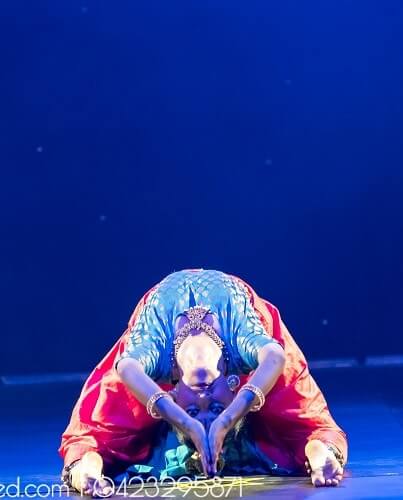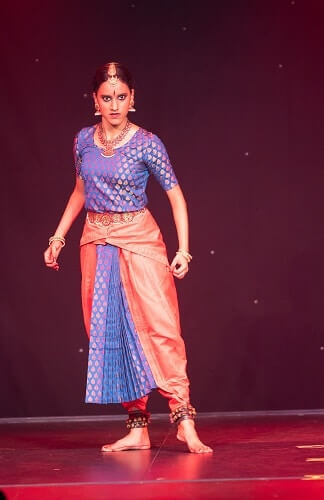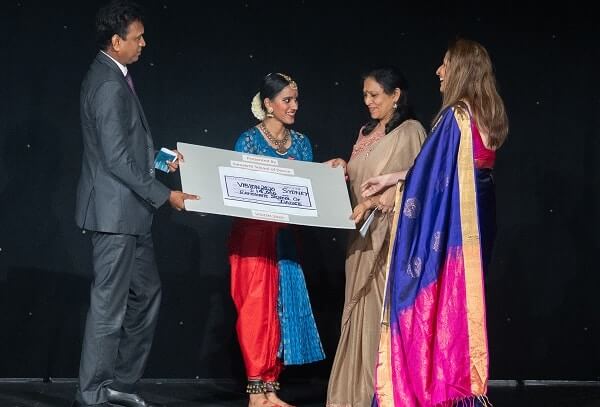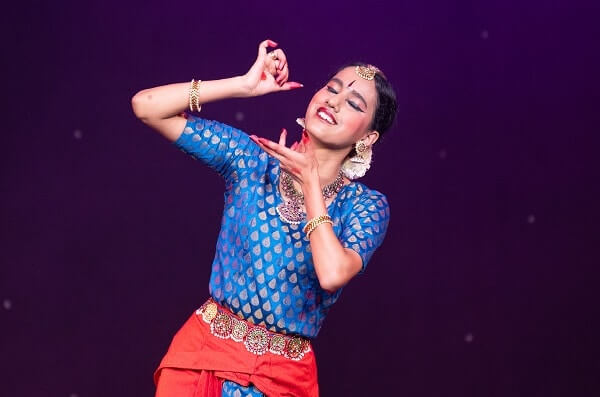There are many ways in which we can touch and make a difference in another’s life. Vishakha Iyer chooses to do that through what she does best – classical dance.
The 18-year-old dancer presented a Bharatanatyam recital ‘Jagriti: An awakening’ in late November in aid of Vision 2020 – a charity organisation that has over the last 20 years raised funds towards worthy causes in India.
She held in thrall a sold-out crowd which included the Consul General of India (Sydney) Dr. S. Janakiraman. Vishakha Iyer’s Jagriti
Vishakha is a multi-disciplinary dancer currently pursuing her Bachelor of Dance at the prestigious WAAPA (Western Australian Academy of Performing Arts), and has trained in Bharatanatyam under Chidambaram R Suresh, Sheejith Krishna and Bragha Besselll in India.
‘Jagriti: An awakening’ touched upon a range of awakenings and realisations from different realms – spiritual, emotional, social, divine and the physical.

Beginning with the universal sound AUM and the story of the source of sound, thath, dhith, thom, nam Vishakha explored the spiritual awakening and the birth of dance in her physical self.
‘Emotional Awakening – Navarasa Mohana’ was based on the nine expressions of emotions that impact and perhaps even dictate our everyday interactions. It was pure delight to see the ease and joy with which Vishakha presented these items, testimony to the fact that ‘she lives and breathes dance’ to use her own words.
The simplicity of costume immediately caught the eye, directing all focus to the dance. It takes immense confidence to strip away frills and highlight pure physical expression. Vishakha Iyer’s Jagriti
The most poignant and though-provoking piece was ‘Vruksha’ (Tree) depicting social awakening. Vishakha danced to the spoken word, scripted and taught by Hamsa Venkat, and a Surdas bhajan choreographed by India-based Sheejith Krishna, about the humble tree, a selfless being. Interwoven into this was the news story of a 113-year-old woman Thimakka and her astonishing relationship to trees. A stunning piece that spanned genres, it combined styles, language and formats in relaying the social message at its core. It was delightfully playful while also thought-provoking, pushing boundaries in the process.
Reflecting later on conception and creation Vishakha said, “This piece awakens awareness at different levels – the social stigma of childlessness in India, the awareness of saving the environment by planting trees and the need for every individual to give back to society – which is a mantra in our home always. Hence it was a win-win in more ways than one.”

Vishakha’s use of her feet – nimble, lithe and energetic at the same time, expressing vulnerability and strength was par excellence and the audience stayed riveted throughout. My mind’s eye still hears and sees the three beats that showed the human arrogance with which the tree was chopped down. Vishakha shone in the mastery of her craft.
Vishakha concluded with a ‘Thillana’ the pure joy of the rhythm of life, and in her unique way reflected on the ups, downs and plateaus of our lives encapsulated in a ‘jugal bandhi’ Perth-based artist Shyam Nair on the tabla.
How did she manage to create an entire repertoire while in Perth, with her gurus and mother Hamsa Venkat elsewhere? “With lots of late-night conversations and endless arguments with Mum over the details and structure,” she grinned. Vishakha Iyer’s Jagrit
iVishakha’s dance training, though rooted in Bharatnatyam, has also explored and studied various other forms like ballet and contemporary. Yet she manoeuvres intelligently through these varied forms of expression. “As I train in multiple dance forms, I’ve come to appreciate the diversity of how different styles interpret the same idea or concept,” Vishakha noted. “I enjoy experimenting with the various ways my body can move and express something through each style. Bharatanatyam places a lot of emphasis on facial expression but contemporary dance focuses on expression through body language, ‘angika abhinaya’ as we would call it in Sanskrit, and it is fascinating when we combine the two. However, no matter how much I explore, Bharatnatyam will always remain my core and support system, offering a sense of grounding and connection that is deeply personal to me.”
Now here’s a young artist who knows her art and understands it deeply.
What role does Bharatanatyam play in her life as a young Indian-Australian? Her reply amazed in its maturity: “As a Bharatnatyam dancer in a western dance society I have felt like an outsider, but simultaneously respected, it’s weird. At the end of the day however, as Martha Graham says, ‘dance is the hidden language of the soul’ – dance is not merely Bharatanatyam or contemporary, it is just movement of the body and the spirit, and the oldest and richest form of communication.”

Anu Shivaram of Vision 2020 said later, “Vishakha Iyer’s Jagriti was truly an awakening at many levels for each member in the audience who were mesmerised watching this young dancer.”
Vishakha also danced into the hearts of the youngsters living in an orphanage in Madala (Andhra Pradesh), for who she helped raise A$14,000 as part of Vision 2020’s 27th annual project.
READ ALSO: Vishakha Iyer: Bharatanatyam for my HSC





